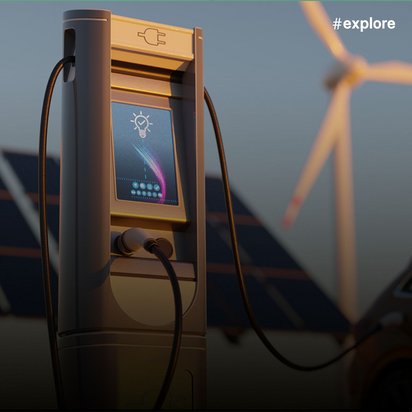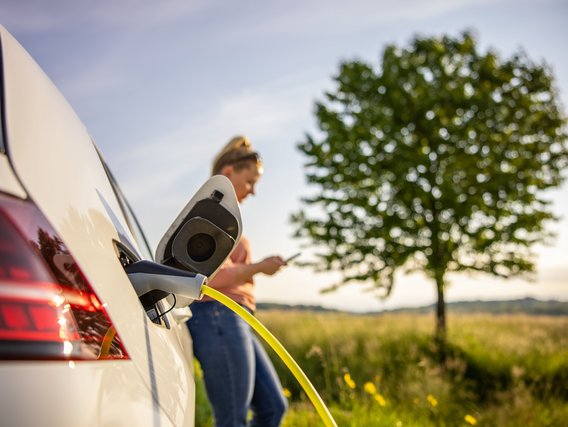Innovation
How clean are renewable energies?
How the Climate Balance of Solar Energy, Wind Power, and Electromobility Stands.

Innovation
How the Climate Balance of Solar Energy, Wind Power, and Electromobility Stands.

09 march 2023
Photovoltaics and wind power are supposed to make our energy more climate-friendly, with electric cars doing the same for our transport. But batteries, solar power systems and the rest do not grow on trees. They need to be built using energy-intensive processes, transported across the globe and recycled at the end of their lives. How big is the CO2 burden associated with renewable energies, and at what point in their lives do they break even?

How much energy does it take to produce them?
One to a maximum of two years. According to the German Environment Agency (UBA), this is the time solar cells in Germany take to generate as much energy as was needed for their production. According to UBA, eight months can be enough in southern Europe. In return, a solar generating system will produce electricity for decades. The manufacturers offer guarantees for 20 to 25 years. But the modules can easily achieve a service life of 30 to 40 years.
What about the carbon footprint?
For as long as they are installed on roofs or in fields, solar panels generate emissions-free energy. However, in the course of their production, transportation and, finally, disposal, climate-harmful CO2 is released. According to UBA, one kilowatt hour of solar power gives rise to a greenhouse effect corresponding to that of 43 to 63 grammes of carbon dioxide. By way of comparison: A lignite-fired power station spews out a whopping 1,140 grammes of CO2 per kilowatt hour of electricity, and even a gas-powered plant will emit 490 grammes for the same output.
As researchers at the Fraunhofer Institute for Solar Energy Systems (ISE) have determined, over half the carbon footprint of a solar module is accounted for by the energy used in its production alone. In China, the world’s biggest producer of solar modules, this energy is generated predominantly from coal. According to Fraunhofer ISE, solar cells produced in Europe generate 40 percent fewer emissions. And this carbon footprint could be improved still further with new technological approaches and changes in design. With frameless glass-glass modules, Fraunhofer ISE says, up to 27 percent of emissions could be saved in comparison to standard glass-foil modules. If solar modules are consistently recycled at the end of their life, UBA says, their carbon footprint can be reduced by a further three to 15 percent.
Unter diesen Gesichtspunkten: Wie und mit welchen Daten werden diese Systeme trainiert, wie werden Datenschutz, Urheberrecht, Diskriminierungsfreiheit und allgemeiner Zugang gewährleistet und gesichert? Auf einer ersten Ebene könnte man so überprüfen, ob das System die erwarteten Ergebnisse liefert. Also ob die Antworten inhaltlich in Ordnung und diskriminierungsfrei sind. In einem weiteren Schritt würde man dann tiefer in das System hineinschauen: Wie ist der Code gebaut? Sind die Trainingsdaten nachvollziehbar gewählt und von hoher Qualität? Lückenlose Sicherheit ist natürlich bei keiner Technologie zu erreichen. Das gilt umso mehr für so komplexe Modelle wie ChatGPT. Aber wir sollten alle Möglichkeiten ausschöpfen, um sie so sicher wie möglich zu machen.
Aktuell ist Google unangefochtener Marktführer bei den Suchmaschinen. Kann Microsoft durch die Integration von ChatGPT das Rennen um die Vorherrschaft der Suchmaschinen nun unter anderen Vorzeichen neu eröffnen?
Carsten Becker: Google ist Bing seit Jahren um Längen voraus, was sich nicht von einem Tag auf den anderen ändern dürfte. Aber die Einbindung von ChatGPT wird Bing qualitativ sicherlich deutlich aufwerten und so wieder für mehr Nutzende interessant machen. Dass Microsoft hier offenbar einen Nerv getroffen hat, zeigt sich ja in Googles nervöser und schneller Reaktion: Das Unternehmen hat bereits einen eigenen KI-Chatbot vorgestellt, der jedoch bei der Präsentation prompt einen Fehler produziert hat, woraufhin der Aktienkurs des Konzerns abgerutscht ist. Doch auch bei Microsoft läuft noch nicht alles glatt. Einige Nutzende haben anscheinend die Grenzen von ChatGPT ausgereizt, worauf der Bot teils unsinnige, teils beleidigende Antworten gegeben hat. Bing hat daher vorübergehend die Zahl der Fragen pro Sitzung beschränkt, bis das Problem behoben ist. Wovon man sicher ausgehen kann: Google verfügt fraglos über das Geld, das Know-how und die Köpfe, um über kurz oder lang zu ChatGPT aufschließen zu können. Letztlich werden wir alle von diesem KI-Wettlauf profitieren, weil die Systeme und die Suchmaschinen dadurch in immer kürzerer Zeit immer besser werden. Fast noch interessanter als die Einbindung von KI-Bots in den Browser dürfte nach meiner Einschätzung aber eine Implementierung von ChatGPT in Microsofts Cloud-Dienst Azure sein. Wenn Unternehmen so auf einfachem Wege auf KI-Funktionalitäten zugreifen können, um Geschäftsmodelle und Lösungen umzusetzen, wird das volkswirtschaftlich gewaltige Auswirkungen haben.
Wie könnte ChatGPT die Internetsuche verändern?
Carsten Becker: Statt wie heute eine Linkliste könnte die Suchmaschine der Zukunft eine fix und fertig ausformulierte Antwort liefern. Einzelne Webseiten anzusteuern wäre damit überflüssig. Was für Nutzende praktisch klingt, wäre für Medienverlage natürlich ein großes Problem. Schließlich müsste niemand mehr ihre Artikel lesen, aus denen der KI-Chatbot seine Antworten generiert. Deutsche Presseverlage wollen daher Lizenzgebühren verlangen, wenn sich die KI von Microsoft oder Google aus ihren Inhalten bedient.

How much energy does it take to produce wind turbines?
Building wind turbines uses a lot of energy – especially in the production of the steel towers and concrete foundations. And yet, according to UBA, the turbines give this energy back after a mere three to eleven months. If you were to shut a wind turbine down after just one year in operation, it would still have generated more energy than was needed to build it. On average, however, the rotors continue to turn for a good 20 years. During this time, they generate 40 to 70 times more energy than is needed for their production, transportation and disposal.
What about the carbon footprint?
When it comes to the carbon footprint of wind turbines, steel and cement is again the most important factor – during their production, a lot of CO2 is pumped into the atmosphere. According to UBA, a modern wind turbine in a rural area with light winds is responsible for the emission of 10.6 grammes of CO2 per kilowatt hour of electricity. At locations with strong winds, the figure is 7.9 grammes; with offshore wind farms, it drops further to a mere 7.3 grammes per kilowatt hour.
After hydropower, which is responsible for four grammes of CO2 per kilowatt hour of electricity, wind power has the best carbon footprint of all the electricity generators. Even a turbine in an area with less wind is 100 times less harmful to the climate than a lignite-fired power station and 46 times less emissions-intensive than a gas-fired power plant. And if the steel for the turbine towers were to be produced using green hydrogen, this would improve their carbon footprint even further.
What good does recycling do?
Copper, aluminium, concrete and steel from wind turbines can already be recycled or reused at the end of their service life. This applies to some 80 to 90 percent of their materials – with the exception, however, of the rotor blades. These are made of compounds such as resin-, glass- and carbon-fibre which are difficult to break down into their component elements and will only yield up their riches in return for large amounts of energy. In the US and some European countries, spent rotor blades currently end up in landfill; in Germany they are shredded and used as an alternative fuel in cement kilns and waste incineration plants. Manufacturer Siemens Gamesa launched the world’s first recyclable rotor blade in 2021. The intention is for the wind turbines from the German-Spanish manufacturer to be completely recyclable by 2040.
What about the carbon footprint?
The carbon footprint of electric cars is a matter of frequent heated debate, both in public and in the social media. One frequently heard assertion is that electric cars are barely or no more climate-friendly than their petrol- or diesel-powered equivalents, as the German electricity mix still contains a lot of coal, and huge amounts of CO2 are generated in the production of their batteries. The fact is that, whereas petrol- and diesel-powered vehicles emit over three-quarters of their carbon dioxide on the road, with electric cars the vast majority of their emissions are accounted for by battery production. This has become steadily more efficient and, consequently, more climate-friendly in recent years. As a study of the International Council of Clean Transportation (ICCT) has reported, the CO2 emissions from an electric compact car in Europe are already 66 to 70 percent lower than those of a comparable petrol- or diesel-powered car. And since the proportion of green electricity in the mix will continue to increase, the researchers say that the green advantage enjoyed by electric cars could go up to as much as 77 percent. Where electric cars are powered exclusively by green electricity, the ICCT reckons that they already generate up to 81 percent fewer emissions than their fossil-fuel counterparts. A current study of the Universität der Bundeswehr München, the university of the German army, goes even further, claiming CO2 savings of nearly 90 percent. According to the researchers’ calculations, a current Tesla Model 3 will have compensated for the CO2 generated by making its battery after just 18,000 kilometres, at which point it will have overtaken a comparable petrol or diesel model.

What good does recycling do?
The researchers from Munich also include CO2 saved by recycling in their calculations. This is because electric cars have a lot of potential here: whereas petrol and diesel are consumed during the combustion process, resulting in the discharge into the atmosphere of climate-damaging carbon dioxide, batteries can enjoy a new lease of life as stationary electricity stores after their removal from cars, and then be recycled. The more widespread this practice, the smaller the carbon footprint. And there is another development which goes hand in hand with the gradual optimisation of battery production: BMW, for example, intends to increase the charging performance and range of the batteries in its next generation of electric cars, scheduled for release in 2025, by around one third. Not only this, but the aim is also to reduce CO2 emissions by 60 percent by using recycled resources such as lithium and cobalt and electricity from solar or wind.
This is an article from #explore. #explore is a digital journey of discovery into a world that is rapidly changing. Increasing connectivity, innovative technologies, and all-encompassing digitalization are creating new things and turning the familiar upside down. However, this also brings dangers and risks: #explore shows a safe path through the connected world.